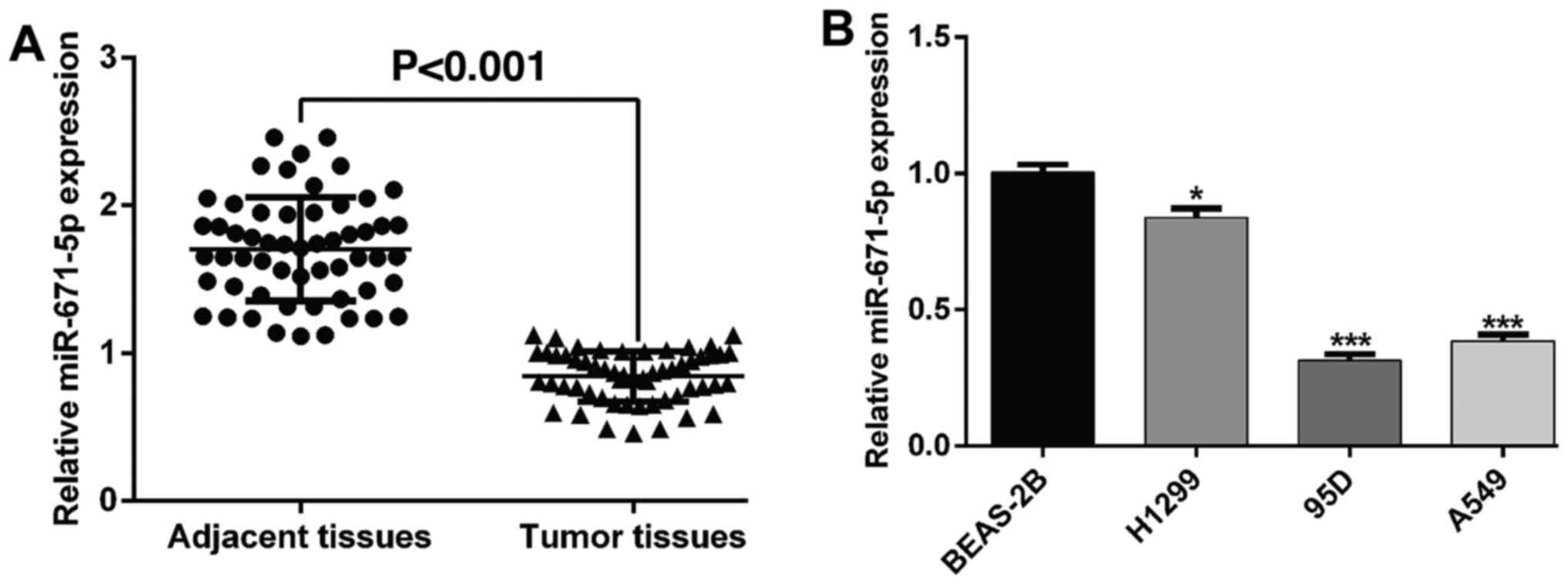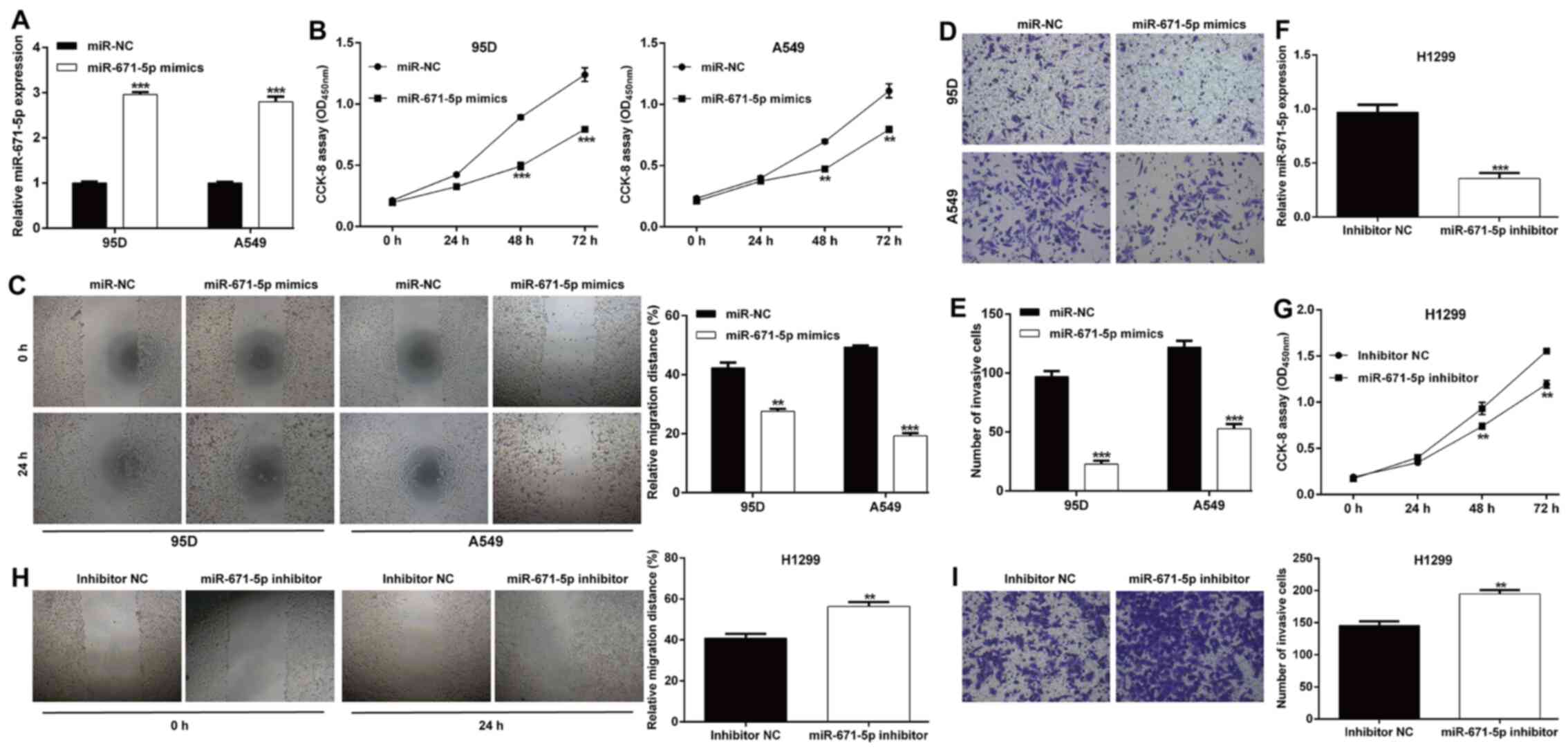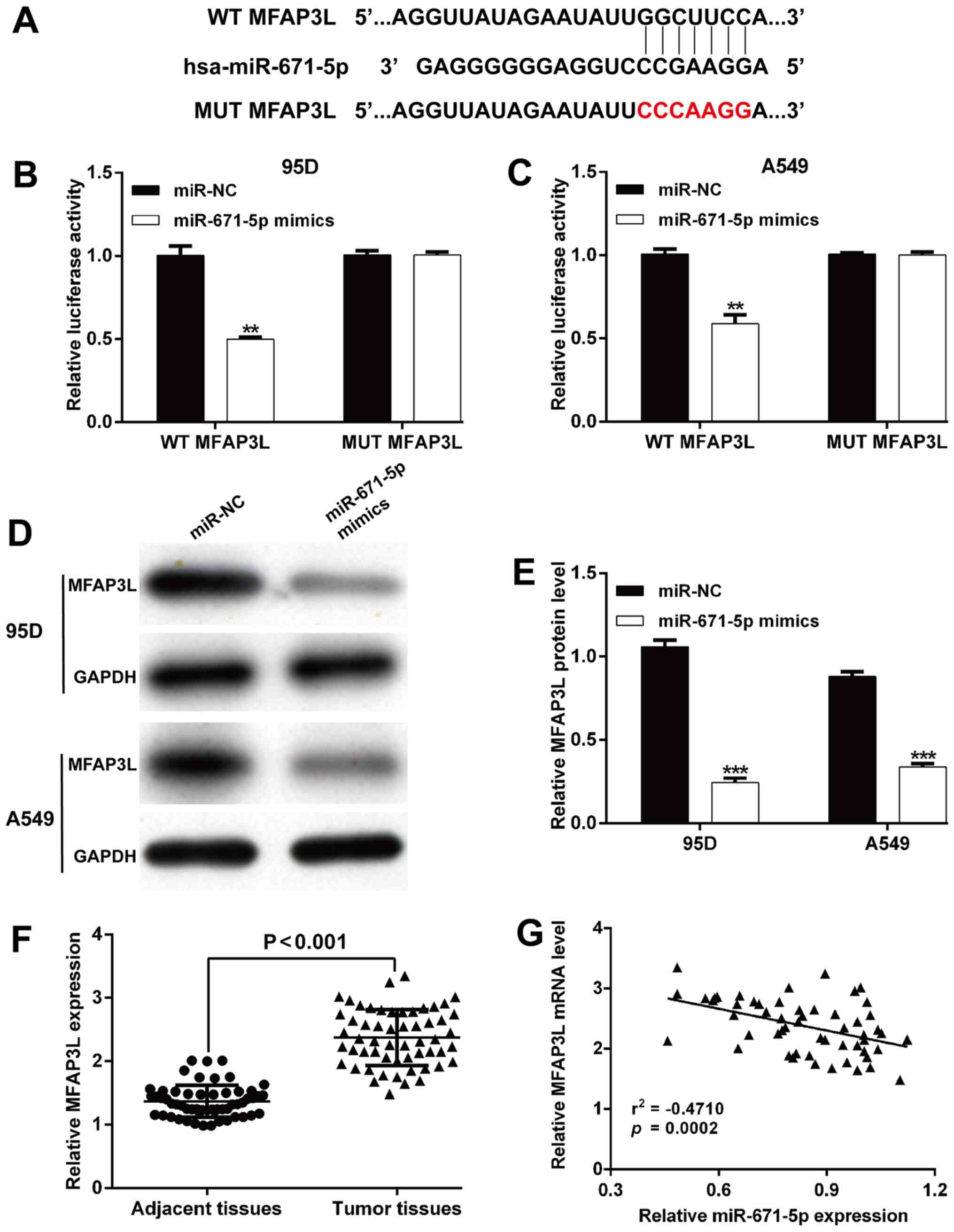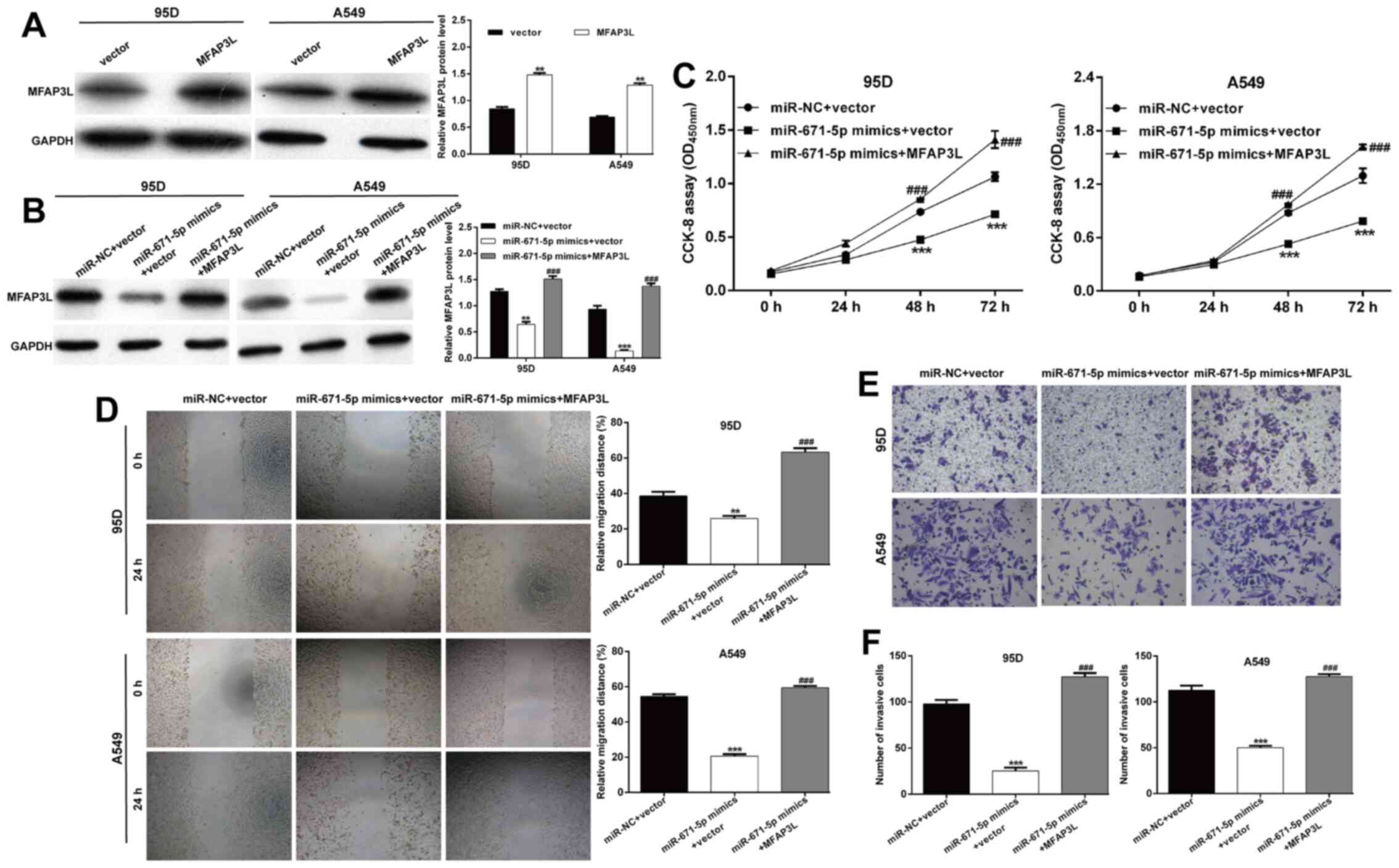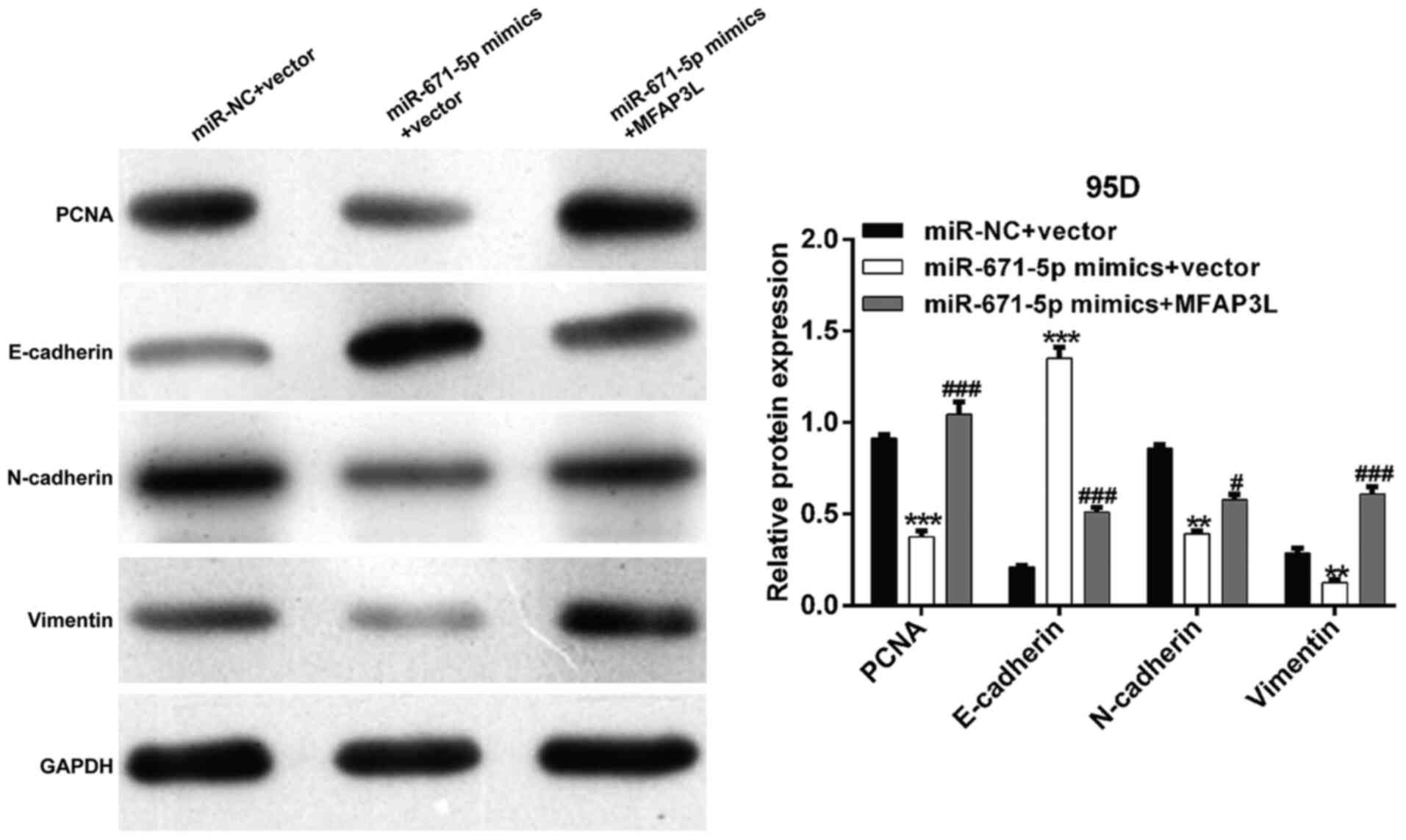|
1
|
Qin H, Wang F, Liu H, Zeng Z, Wang S, Pan
X and Gao H: New advances in immunotherapy for non-small cell lung
cancer. Am J Transl Res. 10:2234–2245. 2018.PubMed/NCBI
|
|
2
|
Wood SL, Pernemalm M, Crosbie PA and
Whetton AD: Molecular histology of lung cancer: From targets to
treatments. Cancer Treat Rev. 41:361–375. 2015. View Article : Google Scholar : PubMed/NCBI
|
|
3
|
Molina JR, Yang P, Cassivi SD, Schild SE
and Adjei AA: Non-small cell lung cancer: Epidemiology, risk
factors, treatment, and survivorship. Mayo Clin Proc. 83:584–594.
2008. View
Article : Google Scholar : PubMed/NCBI
|
|
4
|
Lewis BP, Burge CB and Bartel DP:
Conserved seed pairing, often flanked by adenosines, indicates that
thousands of human genes are microRNA targets. Cell. 120:15–20.
2005. View Article : Google Scholar : PubMed/NCBI
|
|
5
|
Bartel DP: MicroRNAs: Genomics,
biogenesis, mechanism, and function. Cell. 116:281–297. 2004.
View Article : Google Scholar : PubMed/NCBI
|
|
6
|
Calin GA and Croce CM: MicroRNA signatures
in human cancers. Nat Rev Cancer. 6:857–866. 2006. View Article : Google Scholar : PubMed/NCBI
|
|
7
|
Macfarlane LA and Murphy PR: MicroRNA:
Biogenesis, function and role in cancer. Curr Genomics. 11:537–561.
2010. View Article : Google Scholar : PubMed/NCBI
|
|
8
|
Bartels CL and Tsongalis GJ: MicroRNAs:
Novel biomarkers for human cancer. Clin Chem. 55:623–631. 2009.
View Article : Google Scholar : PubMed/NCBI
|
|
9
|
Tan X, Li Z, Ren S, Rezaei K, Pan Q,
Goldstein AT, Macri CJ, Cao D, Brem RF and Fu SW: Dynamically
decreased miR-671-5p expression is associated with oncogenic
transformation and radiochemoresistance in breast cancer. Breast
Cancer Res. 21:892019. View Article : Google Scholar : PubMed/NCBI
|
|
10
|
Tan X, Fu Y, Chen L, Lee W, Lai Y, Rezaei
K, Tabbara S, Latham P, Teal CB, Man YG, et al: miR-671-5p inhibits
epithelial-to-mesenchymal transition by downregulating FOXM1
expression in breast cancer. Oncotarget. 7:293–307. 2016.
View Article : Google Scholar : PubMed/NCBI
|
|
11
|
Li X, Nie C, Tian B, Tan X, Han W, Wang J,
Jin Y, Li Y, Guan X, Hong A, et al: miR-671-5p Blocks the
progression of human esophageal squamous cell carcinoma by
suppressing FGFR2. Int J Biol Sci. 15:1892–1904. 2019. View Article : Google Scholar : PubMed/NCBI
|
|
12
|
Xin C, Lu S, Li Y, Zhang Y, Tian J, Zhang
S, Yang S, Gao T and Xu J: miR-671-5p inhibits tumor proliferation
by blocking cell cycle in osteosarcoma. DNA Cell Biol. 38:996–1004.
2019. View Article : Google Scholar : PubMed/NCBI
|
|
13
|
Chi XG, Meng XX, Ding DL, Xuan XH, Chen
YZ, Cai Q and Wang A: HMGA1-mediated miR-671-5p targets APC to
promote metastasis of clear cell renal cell carcinoma through Wnt
signaling. Neoplasma. 67:46–53. 2020. View Article : Google Scholar : PubMed/NCBI
|
|
14
|
Li X and Diao H: Circular RNA circ_0001946
acts as a competing endogenous RNA to inhibit glioblastoma
progression by modulating miR-671-5p and CDR1. J Cell Physiol.
234:13807–13819. 2019. View Article : Google Scholar : PubMed/NCBI
|
|
15
|
Albig AR, Becenti DJ, Roy TG and Schiemann
WP: Microfibril-associate glycoprotein-2 (MAGP-2) promotes
angiogenic cell sprouting by blocking notch signaling in
endothelial cells. Microvasc Res. 76:7–14. 2008. View Article : Google Scholar : PubMed/NCBI
|
|
16
|
Mok SC, Bonome T, Vathipadiekal V, Bell A,
Johnson ME, Wong KK, Park DC, Hao K, Yip DK, Donninger H, et al: A
gene signature predictive for outcome in advanced ovarian cancer
identifies a survival factor: Microfibril-associated glycoprotein
2. Cancer Cell. 16:521–532. 2009. View Article : Google Scholar : PubMed/NCBI
|
|
17
|
Spivey KA and Banyard J: A prognostic gene
signature in advanced ovarian cancer reveals a
microfibril-associated protein (MAGP2) as a promoter of tumor cell
survival and angiogenesis. Cell Adhes Migr. 4:169–171. 2010.
View Article : Google Scholar
|
|
18
|
Xiao J, Yin L, Li J, Zu H, Zhou Z, Zhao B
and Sha J: Molecular cloning, identification and characteristics of
NYD-SP9: Gene coding protein kinase presumably involved in
spermatogenesis. Chin Sci Bull. 47:896–901. 2002. View Article : Google Scholar
|
|
19
|
Wu JH, Tian XY and Hao CY: The
significance of a group of molecular markers and
clinicopathological factors in identifying colorectal liver
metastasis. Hepatogastroenterology. 58:1182–1188. 2011. View Article : Google Scholar : PubMed/NCBI
|
|
20
|
Lou X, Kang B, Zhang J, Hao C, Tian X, Li
W, Xu N, Lu Y and Liu S: MFAP3L activation promotes colorectal
cancer cell invasion and metastasis. Biochim Biophys Acta.
1842:1423–1432. 2014. View Article : Google Scholar : PubMed/NCBI
|
|
21
|
Wang J, Wu N, Zheng Q, Feng Y, Yan S, Lv
C, Li S, Wang Y and Yang Y: Evaluation of the 7th edition of the
TNM classification for lung cancer at a single institution. J
Cancer Res Clin Oncol. 140:1189–1195. 2014. View Article : Google Scholar : PubMed/NCBI
|
|
22
|
Livak KJ and Schmittgen TD: Analysis of
relative gene expression data using real-time quantitative PCR and
the 2(−ΔΔC(T)) method. Methods. 25:402–408. 2001. View Article : Google Scholar : PubMed/NCBI
|
|
23
|
Chen X, Zhang C and Wang X: Long noncoding
RNA DLEU1 aggravates osteosarcoma carcinogenesis via regulating the
miR-671-5p/DDX5 axis. Artif Cells Nanomed Biotechnol. 47:3322–3328.
2019. View Article : Google Scholar : PubMed/NCBI
|
|
24
|
Qiu T, Wang K, Li X and Jin J: miR-671-5p
inhibits gastric cancer cell proliferation and promotes cell
apoptosis by targeting URGCP. Exp Ther Med. 16:4753–4758.
2018.PubMed/NCBI
|
|
25
|
Song H, Xu Y, Xu T, Fan R, Jiang T, Cao M,
Shi L and Song J: CircPIP5K1A activates KRT80 and PI3K/AKT pathway
to promote gastric cancer development through sponging miR-671-5p.
Biomed Pharmacother. 126:1099412020. View Article : Google Scholar : PubMed/NCBI
|
|
26
|
Jin W, Shi J and Liu M: Overexpression of
miR-671-5p indicates a poor prognosis in colon cancer and
accelerates proliferation, migration, and invasion of colon cancer
cells. OncoTargets Ther. 12:6865–6873. 2019. View Article : Google Scholar : PubMed/NCBI
|
|
27
|
Ma C, Nie ZK, Guo HM and Kong Y:
MiR-671-5p plays a promising role in restraining osteosarcoma cell
characteristics through targeting TUFT1. J Biochem Mol Toxicol.
34:e224902020. View Article : Google Scholar : PubMed/NCBI
|
|
28
|
Zhang B: Guizhi Fuling pills inhibit the
proliferation, migration and invasion of human cutaneous malignant
melanoma cells by regulating the molecular axis of LncRNA
TPT1-AS1/miR-671-5p. Cell Mol Biol (Noisy-le-grand). 66:148–154.
2020. View Article : Google Scholar : PubMed/NCBI
|
|
29
|
Savci-Heijink CD, Halfwerk H, Koster J and
van de Vijver MJ: A novel gene expression signature for bone
metastasis in breast carcinomas. Breast Cancer Res Treat.
156:249–259. 2016. View Article : Google Scholar : PubMed/NCBI
|















